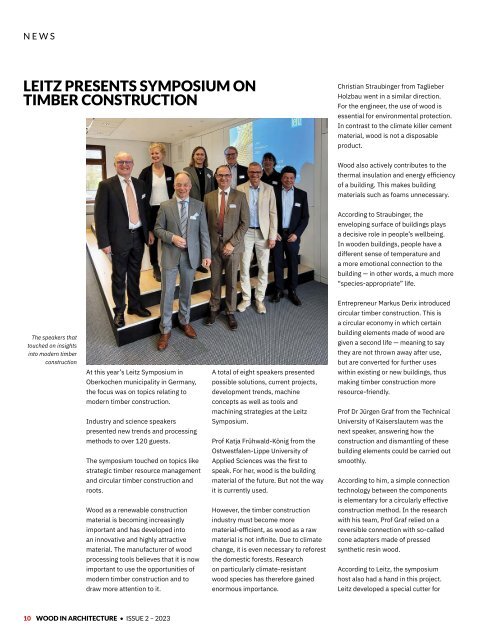WIA_ISSUE2_2023
Create successful ePaper yourself
Turn your PDF publications into a flip-book with our unique Google optimized e-Paper software.
NEWS<br />
LEITZ PRESENTS SYMPOSIUM ON<br />
TIMBER CONSTRUCTION<br />
Christian Straubinger from Taglieber<br />
Holzbau went in a similar direction.<br />
For the engineer, the use of wood is<br />
essential for environmental protection.<br />
In contrast to the climate killer cement<br />
material, wood is not a disposable<br />
product.<br />
Wood also actively contributes to the<br />
thermal insulation and energy efficiency<br />
of a building. This makes building<br />
materials such as foams unnecessary.<br />
According to Straubinger, the<br />
enveloping surface of buildings plays<br />
a decisive role in people’s wellbeing.<br />
In wooden buildings, people have a<br />
different sense of temperature and<br />
a more emotional connection to the<br />
building — in other words, a much more<br />
“species-appropriate” life.<br />
Entrepreneur Markus Derix introduced<br />
circular timber construction. This is<br />
a circular economy in which certain<br />
The speakers that<br />
touched on insights<br />
into modern timber<br />
construction<br />
At this year’s Leitz Symposium in<br />
Oberkochen municipality in Germany,<br />
the focus was on topics relating to<br />
modern timber construction.<br />
Industry and science speakers<br />
presented new trends and processing<br />
methods to over 120 guests.<br />
The symposium touched on topics like<br />
strategic timber resource management<br />
and circular timber construction and<br />
roots.<br />
Wood as a renewable construction<br />
material is becoming increasingly<br />
important and has developed into<br />
an innovative and highly attractive<br />
material. The manufacturer of wood<br />
processing tools believes that it is now<br />
important to use the opportunities of<br />
modern timber construction and to<br />
draw more attention to it.<br />
A total of eight speakers presented<br />
possible solutions, current projects,<br />
development trends, machine<br />
concepts as well as tools and<br />
machining strategies at the Leitz<br />
Symposium.<br />
Prof Katja Frühwald-König from the<br />
Ostwestfalen-Lippe University of<br />
Applied Sciences was the first to<br />
speak. For her, wood is the building<br />
material of the future. But not the way<br />
it is currently used.<br />
However, the timber construction<br />
industry must become more<br />
material-efficient, as wood as a raw<br />
material is not infinite. Due to climate<br />
change, it is even necessary to reforest<br />
the domestic forests. Research<br />
on particularly climate-resistant<br />
wood species has therefore gained<br />
enormous importance.<br />
building elements made of wood are<br />
given a second life — meaning to say<br />
they are not thrown away after use,<br />
but are converted for further uses<br />
within existing or new buildings, thus<br />
making timber construction more<br />
resource-friendly.<br />
Prof Dr Jürgen Graf from the Technical<br />
University of Kaiserslautern was the<br />
next speaker, answering how the<br />
construction and dismantling of these<br />
building elements could be carried out<br />
smoothly.<br />
According to him, a simple connection<br />
technology between the components<br />
is elementary for a circularly effective<br />
construction method. In the research<br />
with his team, Prof Graf relied on a<br />
reversible connection with so-called<br />
cone adapters made of pressed<br />
synthetic resin wood.<br />
According to Leitz, the symposium<br />
host also had a hand in this project.<br />
Leitz developed a special cutter for<br />
10 WOOD IN ARCHITECTURE • ISSUE 2 – <strong>2023</strong>

















